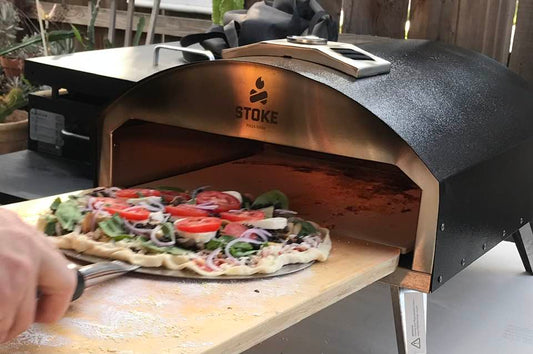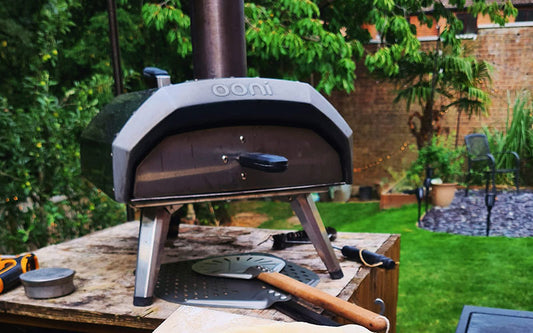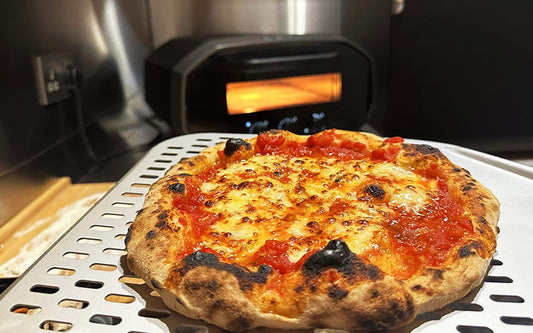Making pizzeria-style pizzas at home is easier when you have the right tool at your disposal. When it comes to homemade pizzas, pizza pans, and pizza crispers are two of the most common cookware used.
They both allow you to cook and serve pizza in your home or commercial kitchen. But what are the differences between these two baking pans? And which one is better for making pizzas in domestic kitchen ovens?
Pizza crispers have holes in them, which are designed to let steam escape while baking, making them ideal for thin-crust pizzas. On the other hand, pizza pans tend to be flatter than pizza crisper and have straight sides instead of sloping ones, resulting in a chewier, bread-like crust.
So, which is the better pizza-baking tool? The answer isn’t quite so simple.
In this article, I am going to explain the benefits of pizza crispers and compare them to pizza pans. I’ll also share some tips for using both tools so that you can get the most out of whatever one you choose.
What Is a Pizza Crisper, Exactly?
A pizza crisper is a baking sheet with little holes in it. These holes are designed to let steam escape from the pizza as it cooks. This prevents soggy crusts and ensures that your pizzas come out crispier than ever before.
Pizza crispers come in all different shapes and sizes, so you can use whatever size fits best into your oven. Generally, pizza crispers are placed at the bottom rack of the oven, directly under the heating elements.
This allows the steam from your pizza to rise up and escape through the holes while also keeping your pies nice and crispy on top.
You can also use a pizza crisper to make other types of foods crispier than usual – like chicken nuggets or fries.
Here’s another cool thing about pizza crispers – they are great for cooking frozen pizzas as well. The pizza crisper is like a mini-oven. It heats up very quickly, so you can put your frozen pizza in there and have it come out nice and hot.
I have also used my pizza crisper to reheat leftovers or make toast with great success.
How Perforations Impact Your Pizza Crust
Okay, now, let’s deep dive into how those tiny holes in a pizza baking utensil impact the finished crust.
Steam Release
The holes in a pizza crisper allow the steam to escape from the dough. More steam release equals a crispier crust. I switched to a pizza crisper for this very same reason. It prevented my crusts from becoming soggy, giving the pizza a more professional look and feel.
Direct Heat Contact for Browning
The perforations in a pizza crisper increase the surface area exposed to direct heat contact. This allows the heat to penetrate the dough more effectively, leading to a consistently cooked crust.
In contrast, when using a solid pan, I often encountered undercooked centers and overcooked edges in the crust. Transitioning to a pizza crisper resolved this issue.
Preventing Dough Bubbling
Holes in a pizza pan also prevent the dough from bubbling up. This ensures the pizza maintains a consistent, flat shape. This would also help you load up your pizza with extra toppings without the risk of them sliding off.
Draining Excess Oil
When excess oil accumulates on the bottom of a pizza, especially in a solid pan, it tends to saturate the crust, making it soggy and less appetizing. This extra fat will also impact the overall flavor of the pizza.
By using a pizza crisper with perforations, the excess oil has an avenue to escape during the cooking process.
As the oil drains away, it keeps the crust from becoming overly greasy. This not only contributes to a crisper texture but also allows the flavors of the crust to shine through without being masked by an excessive amount of oil.
Textural Difference
Due to the factors mentioned above, the crust baked on a pizza crisper is like a cracker – crispy and rigid. On the other hand, a pan crust is more like a soft pillow. Now, there’s absolutely nothing wrong with that.
But I like the extra bit of crunch on my pizza. My pan pizzas often turn out too soft and chewy for my liking.
That said, I’d recommend a solid pan for pizzas that benefit from a softer and thicker crust. If you prefer a pizza with a more bread-like texture or if you’re making deep-dish pizzas, opt for a pizza pan. It will trap some moisture, making the dough soft and pillowy.
Pizza Crisper vs Pizza Pan: A Quick Experiment
To put all the above-mentioned theories into practice, I decided to bake two pizzas using different methods – one on a pizza crisper and the other on a solid pizza pan. I used a simple homemade pizza dough recipe with some minor adjustments.
Pizza Crisper
For the pizza on the crisper, I rolled out the dough to a thin consistency, spreading a classic tomato sauce and topping it with mozzarella cheese, pepperoni, and bell peppers.
- Dough Hydration: I maintained a hydration level of around 65%, striking a balance for a thin, yet manageable, dough.
- Proofing Time: The dough proofed for an hour at room temp and overnight in the fridge.
- Baking Time: The pizza on the crisper was baked at 450°F (232°C) for about 12 minutes.
Solid Pizza Pan
For the pizza on the solid pan, I rolled the dough a bit thicker to see how it would affect the texture. Similar classic toppings were used: tomato sauce, mozzarella, pepperoni, and bell peppers.
- Dough Hydration: With a slightly higher hydration level of 70%, the dough for the pan pizza had a bit more moisture to contribute to a softer texture.
- Proofing Time: I extended the proofing time for the pan pizza to 2 hours at room temp and overnight in the fridge.
- Baking Time: I baked it at the same temperature, 450°F (232°C), but for a longer duration of 15 minutes to accommodate the thicker crust.
The Takeaways:
Texture: As anticipated, the crisper pizza lived up to its name. With a satisfying crunch in every bite, the crust boasted a delightful crispiness, elevating the overall experience.
In contrast, the solid pan pizza leaned towards a softer texture, offering a comforting chewiness that felt more akin to a traditional, homemade style.
Browning: The crisper pizza showcased an even browning across its entire expanse. It created a visually appealing golden hue that hinted at a perfectly baked crust.
The solid pan pizza, however, exhibited a bit more drama in its browning. The edges took on a beautiful golden color, slightly more pronounced than the center. I loved the rustic look of this pizza.
Ability to Hold the Toppings: Toppings on the crisper pizza adhered seamlessly to the crisp crust, creating a harmonious symphony of flavors without any risk of fogginess.
The thicker and softer crust of the pan pizza struggled a bit with the topping tango. Towards the center, toppings showed a tendency to meander. This led to a more rustic and homemade presentation.
When to Use a Pizza Pan?
Pizza pans have been around for decades and are more widespread than pizza crispers. Pizza pans are round and made of metal, with a lip around the edge. The pans are generally coated with some sort of non-stick coating and come in various sizes.

The metal build allows pizza pans to retain more heat, resulting in faster cook time. The most common size is 12 inches, and it goes all the way up to 14 inches.
You can also find pizza pans in square and rectangular shapes. Pizzas baked in a pizza pan generally tend to be on the thicker side. So, a pizza pan is a way to go if you like thick slices with lots of sauce and toppings.
Pizza pans are also a great option for making Pizza Hut-style pan pizzas, which are typically baked in the oven for about 15 minutes before being topped with sauce and cheese. In addition, you can use a pizza pan as a baking sheet for other types of dishes, such as cookies, bread or chicken tenders.
Read Next: Best Wood Fired Pizza Oven to Bake Like a Top Pizzaiolo
Chicago-style deep dish pizzas require a different type of pan than regular pizzas. Deep dish pizzas are baked in a rectangular baking pan with a removable bottom, which makes it easier for you to serve the slices without making a mess.
Pizza Crisper Vs. Pizza Pan – Comparison Table
To give you a better understanding of the differences between pizza screens and pizza pans, I have created a comparison table. This will help you decide which one is the best option for you.
| Key Differences | Pizza Crisper | Pizza Pan |
| Material | Heavy-duty aluminum, nickel-free stainless steel | Heavy-gauge aluminized steel, carbon steel, cast iron, ceramic or cordierite stone |
| Perforations | It has several holes which allow heat to escape, resulting in a crispy, crunchy base | Non-perforated, therefore, heats up more quickly and evenly, resulting in a softer, fluffier base. |
| Durability | Exceptionally durable and scratch-resistant | The non-stick coating tends to wear off after a few months of heavy use |
| Typical Size | Commonly available sizes range from 9-14″ | Sizes range from sizes ranging from 6” to 20 |
| Ideal Use | Thin-crust Italian crust pizzas, toast, crispy chicken nuggets. Best for cooking frozen pizzas as well. | Soft and chewy deep dish and other homestyle pizzas made from fresh dough. Also great for baking cakes, tarts, cookies, and certain kinds of bread like focaccia. |
| Baking Temperature | Ideally between 450 and 500 degrees F, and bake the pizza for 8 to 20 minutes, depending on the thickness of the crust | Bake at the same temperature but for longer period, around 20-25 minutes to allow all the moisture to evaporate. |
| Shaping | Stretch thinly by hand. | Roll it out and press onto the pan. |
| Oven Spring | Minimal rise due to steam release | More oven spring from moisture retention |
| Dishwasher Safe | Yes | Yes |
| Suitable Ovens | Microwave, OTG, convection ovens | All kinds of ovens, including wood-fired ovens |
| Advantages | Fast baking, uniform browning, extra crispness. | Versatility for all pizza styles, easier handling. |
| Limitations | Not ideal for thick or stuffed crusts | Can soften thin crusts, limit crispness |
Crisper vs. Screen vs. Pan: The Quest for the Perfect Pizza
The easier way to put an end to a pizza pan with holes vs. no holes debate is to consider what kind of pizzas you intend to make.
For example, if we are talking classic Italian-style pizzas, then pizzas with no holes, i.e., pizza crispers or screens, would be a better option than pizza pans in standard convection ovens.
The holes in the pan allow for an even distribution of heat and help in browning the crust. Both pizza screens and pizza crispers have holes in them. The only real difference is that pizza screens are essentially flat mesh disks made of heat-retardant aluminum.
They are more lightweight than pizza crispers which are built from heavy-gauge aluminum or carbon steel.
Pizza screens will result in an even crispier crust than pizza crispers. They are better suited for microwave ovens and small kitchen ovens.
Pizza pans are rather better suited for thicker, chewier pizzas, like a deep dishes or Detroit-style pizzas.
The pizza pan is also a better option when you are making calzones, cookies, brownies, focaccia, and many other baked goodies.
Final Verdict
At the end of the day, it all comes down to what kind of pizza crust you intend to make and the type of oven you’re using.
In my humble opinion, pizza pans are more versatile cookware and can be used for a wide range of recipes, whether it’s pizza or cookies.
On the other hand, pizza screens are better suited for making thin-crust pizzas and helping your food cook faster in small convection ovens or microwave ovens.
If you’re looking for a multi-purpose cookware that can be used for any type of pizza crust or other recipes, then I highly recommend purchasing a pizza pan. However, if you want to make pizzas with crispy thin crusts and toasts, then I recommend getting a pizza screen instead.




